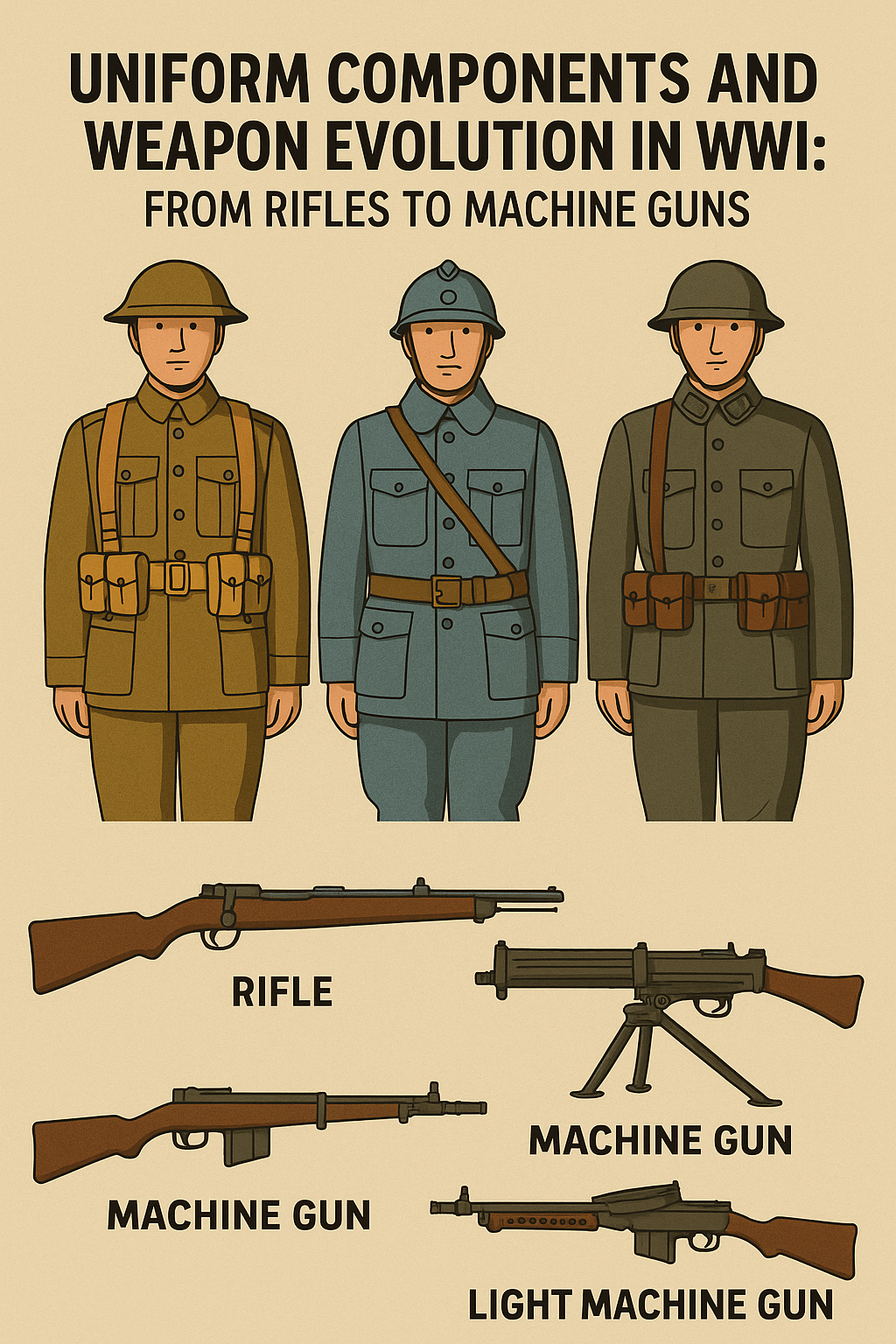
Uniform Components and Weapon Evolution in WWI: From Rifles to Machine Guns
Published on Apr 21, 2025
Uniform Components in WWI: Function Over Fashion
At the outbreak of the First World War in 1914, most military forces in Europe were still relying on uniforms rooted in 19th-century traditions. However, the realities of trench warfare and industrial-scale combat forced rapid changes.
1. Material and Color
Uniform colors shifted from bright, decorative tones to more muted, camouflaged designs. The British switched to khaki, the French moved from red trousers to a "horizon blue," and the German uniform adopted a dull grey-green "feldgrau." These color choices were vital for blending into muddy battlefields and avoiding sniper fire.
2. Core Uniform Elements
Despite differences in color, most WWI uniforms shared these core components:
- Tunic and trousers – Heavy wool to withstand harsh weather and wear.
- Puttees – Long cloth strips wrapped around the lower legs to offer protection and support.
- Helmet – Initially, soft caps were common, but as artillery improved, steel helmets like the British Brodie and German Stahlhelm became standard.
- Webbing and pouches – Carried ammunition, water, food, grenades, and personal items.
3. Protection and Adaptation
As the war progressed, uniform designs were adapted for the brutal conditions of trench warfare. Waterproof capes, gas masks, and reinforced boots were added to protect soldiers from chemical weapons, mud, and disease.
The Backbone of Combat: Rifles in World War I
Rifles were the standard weapon issued to infantry across all armies. Though each country had its own design, the core function remained the same: to deliver accurate, long-range fire from the trenches.
1. Notable WWI Rifles
- Short Magazine Lee-Enfield (British) – Famous for its high rate of fire and smooth bolt action.
- Gewehr 98 (German) – A rugged, reliable bolt-action rifle with excellent accuracy.
- Lebel 1886 (French) – The first rifle to use smokeless powder, though it became outdated by mid-war.
2. Use in Trench Warfare
In tight, muddy trenches, rifles were often fitted with bayonets to serve as close-quarters combat tools. The rifle’s reliability and simplicity were critical, especially in dirty conditions where jams could be deadly.
3. 1st World War Rifles: A Technological Leap
WWI rifles marked a transition from older musket-style weapons to more advanced, efficient firearms. They had better range, more accuracy, and quicker reloading times than previous generations.
Explosives and Their Role in WWI Combat
One of the most significant advancements in WWI was the widespread use of explosives, both on a large and small scale.
1. From Black Powder to TNT
Pre-war explosives used black powder, which was less stable and produced heavy smoke. WWI introduced high explosives like TNT and cordite, which were far more powerful and efficient.
2. Hand Grenades
Hand grenades became a trench staple. Soldiers used them for clearing enemy dugouts and defending positions. The British Mills bomb and German "stick grenade" were iconic, allowing for short-range yet deadly attacks.
3. Explosives in Mining Operations
Beyond handheld use, explosives were used to tunnel under enemy lines and set massive charges that could destroy entire trench systems. This introduced a terrifying underground dimension to warfare.
The Machine Gun Revolution
Machine guns redefined warfare in WWI, contributing heavily to the defensive stalemate that characterized much of the conflict.
1. Early Models
At the start of the war, machine guns were bulky, water-cooled, and often stationary. They required several men to operate effectively and were generally used to defend fixed positions.
2. Disadvantages of Machine Guns in WW1
Despite their firepower, these weapons had significant drawbacks:
- Weight and size – Early models were extremely heavy and difficult to move.
- Overheating – Water-cooled systems could fail under sustained fire.
- Crew dependency – Operating a machine gun effectively often required a team of 4 to 6 men.
- Ammunition demands – They consumed massive amounts of ammo, creating logistical challenges.
3. Evolution of Light Machine Guns
To address these issues, lighter machine guns were introduced:
- The Lewis Gun became a staple in the British forces due to its portability and reliability.
- Other countries developed similar models to give infantry squads greater mobility and firepower.
How Uniforms and Weapons Defined the Soldier’s Experience
The combination of evolving uniforms and deadly new weaponry shaped every soldier's daily reality. Gone were the days of brightly dressed lines marching into open battle. In their place stood the mud-caked, steel-helmeted figures of the trenches, armed with precise rifles, deadly grenades, and devastating machine guns.
Uniforms no longer just represented a nation—they had to protect, carry gear, and adapt to every battlefield challenge. Meanwhile, the weaponry shifted from symbolic muskets to powerful machines capable of delivering mass destruction.
Final Thoughts
World War I was not only a battle of nations but also a battle of innovation. From uniform components designed for survival to weaponry that changed how wars were fought, the First World War laid the groundwork for modern military tactics and gear.
Understanding the components of uniforms and the function of WWI rifles, explosives, and machine guns helps paint a vivid picture of how warfare evolved—and how those evolutions shaped history itself.
